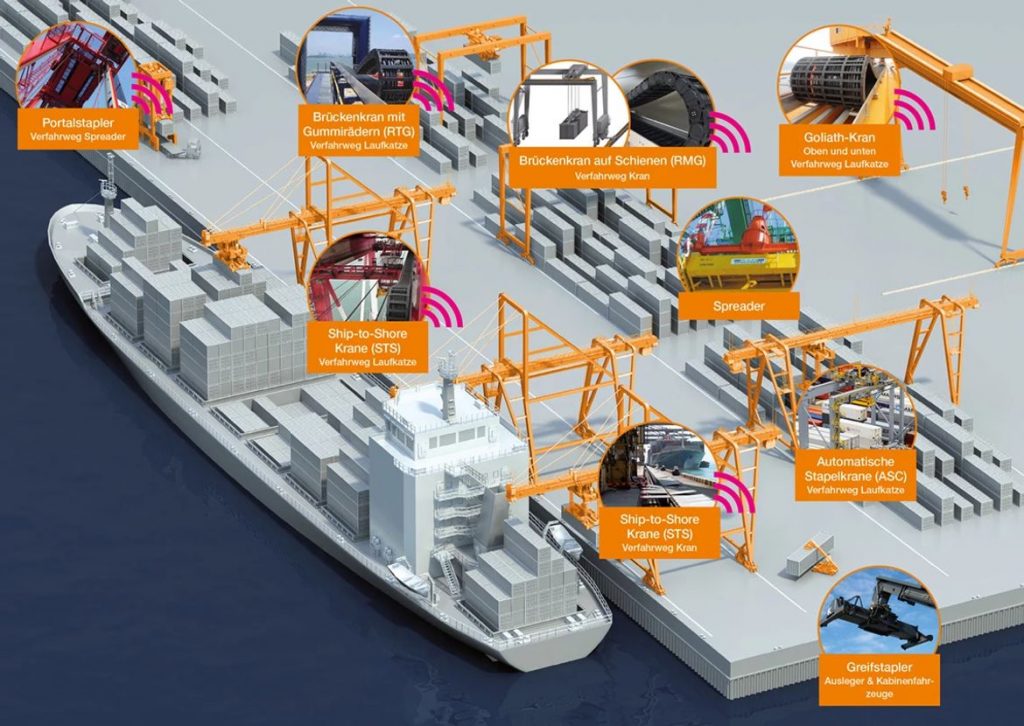Electrification… Digitalisation… Monetisation: With smart energy supply systems towards more productivity for port crane operators
Richard Habering | 18. August 2022
If the waist gets thicker, new trousers must be found. This applies to ports all over the world. Modern container ships such as the Ever Ace are 400 metres long, 62 metres wide and load almost 24,000 containers. In this case, the larger trousers are similar to a larger ship-to-shore (STS) crane that loads and unloads the containers. This presents a challenge to ports all over the world. The performance of a crane is directly dependent on its electrification system. And that infrastructure must continuously operate without malfunctions seven days a week, 24 hours a day. In all weathers, with high UV exposure, fluctuating temperatures and salty air. As there are various power supply options, it can be difficult to make a decision about the right system.
Traditional energy supply solutions are increasingly reaching their limits
One power supply system that is frequently offered for overhead cranes is an open or insulated busbar system. These horizontal metal conductors supply the crane with electricity via steel or copper conductor bars along the track or bridge. However, busbar systems are limited in terms of the types of energy they can supply. On a busbar system, each conductor or pole requires its own conductor bar and collector. Hoses and other cable types must be guided by a separate system. They also expose unprotected power cables to the environment, which can be problematic in applications that are installed near salt water or where chemical vapours occur.
In the past, the answer was usually “festoons” or “festooning”, i.e. drag chains or guide chains, named so due to their external appearance of a garland. Festooning consists of freely tensioned supply cables with integrated steel ropes for strain relief. As a rule, the cables hang unprotected on the crane and are moved dynamically by additional drives, i.e. retracted and extended. A major disadvantage of festooning is that they can get caught and tangled up in the harbour basin during windy operation, resulting in unexpected shutdowns. Due to the suspension in cable loops, the need for cable length is also enormous.
Energy supply systems made of high-performance plastic are increasingly becoming the standard for harbour cranes
An electrification system that can solve these problems and deliver higher performance in most applications at the same time is an energy chain system. Energy chains are often referred to as the umbilical cord of modern machines. Energy chains are high-strength plastic cable carriers that reliably protect cables during constant movement. The design is modular and can be adapted to a wide range of applications. Unlike steel systems, plastic energy chain systems are designed to resist abrasion and corrosion. Plastic also reduces weight and offers vibration-dampening specifications. The space requirement is also significantly reduced by energy chains. Less cable length and the elimination of the loop station create additional space that can be used to install additional cybernetic and sensory systems. In this way, switch cabinets can be installed on the crane trolley and, if necessary, more powerful units can be integrated.

Especially in the age of Industry 4.0, these sensory or digital systems are becoming increasingly important in order to be able to counter increasing competitive pressure with better productivity. Energy supply systems from igus, for example, enable so-called predictive maintenance. With the help of i.Sense monitoring sensors, the status of the
chain links can be continuously transmitted to the i.Cee:plus communication module. By using i.Cee, users can rely on usage and condition-based maintenance, thus extending the periods between individual inspection intervals. Maintenance is only necessary when the system gives an appropriate signal. Operators of port cranes can significantly increase plant availability with the i.Cee system. Company holidays and other planned downtimes are automatically taken into account in the service life calculation by i.Cee and the forecast is constantly checked using sensors.
Modern sensor technology paired with intelligent algorithms promise optimum productivity
As an intelligent “preventive maintenance” system, i.Cee consists of three levels: sensors, hardware and data collection/evaluation. At the heart of the system is the software. It creates the conditions for intelligent, condition-based and individual service life calculation and continuous monitoring of the energy supply system in the port. The i.Cee software calculates the service life of the polymer component on the basis of the actual load. This works as follows: when starting the operation or the software, the service life is compared with the algorithms of the current online service life calculator. The manually recorded environmental and movement data is applied, and the double strokes and/or kilometre readings are transferred to the software. It converts the data in terms of days. This results in the service life up to the recommended replacement, assuming the anticipated movement data with 24/7 use and constant impact of the maximum environmental data.
The intelligent e-chains from igus are already being used on the shipyard cranes of Chinese shipbuilder Waigaoqiao Shipbuildung Co. Ltd. (SWS). It is as tall as a 30-storey high-rise building and can withstand typhoons. “The igus energy supply system has been running smoothly since it was installed and has required minimal maintenance,” says Zhang Quan, Head of the SWS Development Department. “As a result, we have saved enormously on labour and materials.” A nice side effect is that the rolling movement reduces the required drive energy by 57%. This benefit should not be underestimated in a time of skyrocketing energy prices. Another example is the port in Norfolk/Virginia. Here, an STS crane with festooning was converted to an energy chain back in 2002. The system’s performance and ease of maintenance were so impressive that all new STS and other port cranes (RTG, RMG, and ASC cranes) are now supplied exclusively with igus e-chains.

